#there needs to be space for both complex and simple portrayals of queer relationships
Explore tagged Tumblr posts
Text
Steven Universe’s Representation and Music: an informal essay
As the first animated Cartoon Network show created entirely by a woman, Steven Universe’s run lasted for five seasons, a movie and a sequel-epilogue series. The show was far from perfect and its fandom wasn’t the best either but there is something so special about a show that followed lesbian space rocks and a young boy saving the world.
More specifically Steven Universe is about a young boy named Steven, who is half-Gem, half-human who protects the town of Beach City from evil. Gems are a kind of alien who take on the form of pastel-coloured women, to better assimilate with the rest of the world.
Rebecca Sugar, the creator, explains her colourful characters in a behind-the-scenes promo:
“I always dreamed of making a show that would have this mix of fantasy and reality. So, I wanted to make these fantasy characters that enjoy being with Steven as much, if not more than they enjoy being fantasy characters. The characters aren’t perfect and that’s what makes them so great.”
Steven’s family are known as the Crystal Gems, a group of rebels who fought against their government thousands of years ago and now live on earth. Steven’s mom, Rose Quartz was at the forefront of the fight, she did extremely terrible things and when she gave up her gem—-so Steven could be born—-she was left unable to form a body ever again. Steven, with only his dad and three alien women, must attempt to fix her messes and deal with the repercussions of his mother’s actions.
One of the main mechanics within the series is known as fusion, in which two or more Gems become a single being who is stronger and more powerful. The fused form takes on the physical, mental and emotional aspects of those who are part of the bond. As mentioned and discussed many times within this blog, fusions are a physical embodiment of different kinds of relationships. And for a show starring a primarily female cast, they do not shy away from using this mechanic to tell queer stories.
So explicitly that in 2018, the show had the first-ever lesbian wedding in a cartoon. Of course, representation wasn’t always as accepted in Steven Universe. Just two years before the big wedding, higher-ups at Cartoon Network told Rebecca Sugar, they not happy with the multiple queer relationships, so much so that they were ready to threaten cancellation.
In an interview with Entertainment Weekly, she expressed:
“If this is going to cost me my show that’s fine because this is a huge injustice and I need to be able to represent myself and my team through this show and anything less would be unfair to my audience.”
Being LGBT herself, identifying as bisexual and non-binary, representation is important to her. For many queer people, especially grown-ups, they hope to see themselves represented in kids’ media today as they never had growing up. They want nothing more for children’s shows to say that being “different” or not fitting in with our heteronormative society is actually normal.
Within Steven Universe, you can find woman-loving-woman relationships, non-binary and intersex characters, woman-loving-non-binary relationships, asexual coded characters and basically every other letter in the acronym.
Rebecca Sugar even acted as the exciting force for LGBT inclusion within Adventure Time, originally working as a writer and storyboard artist before leaving to create her own show. She pushed for making the ex-romantic queer couple to be canonically part of the story and for it to not just coded into the dialogue.
A few years later, she returned to the show, multiple times, to compose over 20 songs that would air over the series 10-year-long run such as, “I’m Just Your Problem” which had lesbian subtext that would be confirmed later.
Some other iconic songs including “Fry Song“, “Remember You“, “Good Little Girl“, “Everything Stays” and even the finale song, “Time Adventure“.
Much like the show as a whole, there is something so special about the music she writes. In total, there were over 160 songs written for the franchise, some being short little tunes, no longer than a minute while others were full-blown musical numbers. No matter, all of them have their place within the show. Often when the character can’t express lines through speech, music is utilized to provide a more raw and poignant portrayal of their emotions.
Why Steven Universe is so widely loved is due to the music, as the overall story is not even close to perfect. Yet, everyone can agree on one thing, the music is unbelievably good. What is interesting is the different styles of melodies and backtracking used in the various songs, even more impressive is that every character has their own instrumental motif.
Steven’s motif is the ukelele as he is often seen playing the instrument himself, performing short little melodies and even writing the in-show version of the theme song. Additionally, Steven’s music uses a large amount of Chiptune synth, electronic music which is created using a programmable sound generator. Both instruments have a very childlike feeling to them, Chiptune especially as it is normally used in video game music like The Legend of Zelda: Ocarina of Time, one of the main musical inspirations for the show. As Steven is the lead, most of the music has Chiptune somewhere in the score and fun fact, the first song in the show, sung by Steven, “Cookie Cat” was actually written on an old Gameboy.
Amethyst is very loud and fun, her motif is electric drums which is extremely reflective of her character. As she can be angry from convincing herself that she is not good enough to happy and giggling from pranking Steven, her instrument can be used in so many ways as she is not a simple character. No matter what, for the few songs Amethyst has on her own (or in the score), her drums provide such an interesting emotional response to the situation.
Garnet is a fusion, so her motif is actually the combination of two instruments. Ruby is a drumbeat as she is a fiery and loud character, she is chaotic while Sapphire is her opposite. Sapphire is calm and collected, she has ice-related powers and is represented by Synth music. The characters together have a perfect unity, expressed by Garnet’s synth bass sounds, she is the equilibrium of two very contrasting characters. The music associated with Garnet, uses primarily the synth bass but Ruby and Sapphire’s individual instruments can be heard throughout her music. All three instruments are also heavily representative as Garnet’s main dancing style is Hip Hop which clashing with others’ softer dancing styles.
Despite, not being alive during the show, Rose Quartz still has her own musical motif as she plays a large part in Steven’s growth throughout the series. As well as being in many flashbacks, she is represented with strings, more specifically, the violin. Rose’s story is rather sad which quite is visible within her associated music, yet, she was also an extremely powerful character as she led the fight against the Homeworld government. Her strength can be heard with strong uplifts and swells in the music. She is never seen playing an instrument unlike the rest of the main characters but one person who plays hers is Pearl, a character Rose was possibly in love with.
For the complex and beautiful character, Pearl, her motif is classical and swing piano. She is visually represented as a ballerina for a large majority of the series, dressed in a leotard, a small skirt and ballet shoes. Apart from Garnet, she is one of the calmest characters in the show. She is a perfectionist and is knowledgeable on many topics. She has a dark past and her fair share of trauma, all of this is wrapped up in her music. From her traumatic past with Rose Quartz, the violin had been heard throughout her music, yet, when she finally dealt with everything, the violin was lost. Swapped out for a new instrument, a bass guitar which she learned how to play at the end of the series. Pearl is a character who has been through a lot and her music reflects it. As she grew, her music changed with her, becoming her own instead of something built off of Rose’s.
My personal favourite song is “It’s Over Isn’t It?” which is this heartwrenching and emotionally painful ballad sung by a broken woman. Pearl was in love with Steven’s mom. Yet, the feelings were not mutual or at least ended being reciprocated as Rose left her for Greg, Steven’s dad. It hurts because Rose didn’t just leave her, Rose Quartz also passed away. As the song goes:
That they didn’t really matter until you I was fine when you came And we fought like it was all some silly game Over her, who she’d choose After all those years, I never thought I’d lose … You won and she chose you and she loved you and she’s gone It’s over, isn’t it? Why can’t I move on? … Who am I now in this world without her? Petty and dull with the nerve to doubt her What does it matter? It’s already done Now I’ve got to be there for her son
Without Rose, Pearl has lost her place in the world as all she ever knew was her. Yet, now she is left to help raise a half-human baby and go on with her life. It makes it more difficult as this baby is the product of Rose and the man that she left Pearl for.
Pearl doesn’t want to hate Greg, she is angry at him but she doesn’t have hatred towards him. They may not be the best of pals at the start of the series but in the song called “Both of You“ has Steven, finally, begging for Greg and Pearl to just talk to each other.
Why don’t you talk to each other? Why don’t you talk to each other? Just give it a try Why don’t you talk about what happened? … You might not believe it but you got a lot in common, you really do You both love me and I love both of you … I know you both need it Someone who knows what you’re going through
An interesting thing about this song is that Steven is this to them, the person with Rose’s gem is singing to the two people who fought over Rose. It makes me wonder if this could be Rose speaking through Steven to her two loved ones. Whether it is or not, doesn’t really matter to the overall story but it is a fun idea to look at.
Overall, these songs are a literal representation of dealing with ones’ emotions in a healthy way, something that Steven Universe actively tries to teach their younger viewers about.
To say Steven Universe is a good show only for its music would be a false statement, it’s one of the strongest aspects but without the story or the characters, the music would fall flat and not have any of its passion.
#isaac rambles#steven universe#lgbt#steven universe music#cartoons#cartoon network#rebecca sugar#cartoon review
2 notes
·
View notes
Text
Best of the Best - Media Consumed 2018
Books - Fiction
The Lies of Locke Lamora - Scott Lynch
I devoured the entire series in a series of months this year and what I’m about to say holds true for all of them (probably more than for the latter two than the first)...but I have a particular soft spot for the plot twists and humor of the beginning. So, it’s my choice for the year, though it is representing the series as a whole.
This is the series that showed me what inclusive fantasy can be like. It’s a story predominantly about straight white dudes written by a straight white dude (a comfort zone I am struggling to break out of) and yet, it is one that purposefully skirts the tropes of the genre and plays with them in such a way that it makes the world feel welcoming to a reader who is neither straight nor male. There’s lesbian pirates, multiple queer characters, copious well-written women and non-white characters as major players in the narrative. This was a book that gave me hope and help as I struggled to bust out of my old patterns of thinking and writing. And yet, it was familiar enough that it was enough of a comfort zone to retreat to in times when I needed to seek comfort in fiction.
And it’s so much good fun. Half a year later and I’m still cracking up at “Nice bird, asshole.”
Books - Nonfiction
Dictator Style - Peter York
This book was weirdly heart-wrenching. There’s something so melancholy and strange about surveying the living spaces of these paragons of human misery and trying to figure out what they were thinking through medium of their wallpaper choices. That, and the knowledge that even the seemingly all powerful are far more tacky and slipshod than commonly believed, stuck with me.
Fic
Batya - Valya
I didn’t read a whole heck of a lot of fic this year and only counted those that were above a 30k word count. There were plenty of short fics that I loved, but alas, I did not write them down. Goals for next year!
So, Batya, BioShock fic - AU in which Ryan discovers Jack far earlier than intended and decides to adopt him as his son. Once this fic gets going, it’s intense. And sad. And beautiful, all of which apply heavily to the relationship between Jack and Kyle. The final scene between them is pure poetry and had me thinking of them dancing as Rapture fell apart around them for days afterward.
Film
I saw so many hecking good movies this year. I’m just barely able to pare it down to a top three.
Black Panther - Ryan Coogler
This movie was exhilarating. The design, the energy, the acting, the humor, the primal drama of two types of activism duking it out in the bowels of the earth...I walked out of the theater in a daze, hardly believing that I’d seen what I had.
When Marnie Was There - Hiromasa Yonebayashi
This movie contains the most accurate portrayal of social anxiety I have ever seen in fiction, period. It hit especially close to home for me, as this year was the one in which I faced and struggled with my own lifelong anxiety. I watched it wondering how on earth filmmakers half a world away got the details of my own childhood down so precisely on film. When the credits hit and “Fine On the Outside” played, I bawled at my computer screen.
Spider-Man: Into the Spiderverse - Bob Persichetti, Peter Ramsey, Rodney Rothman
This movie was a staggering technological accomplishment. It pushed the boundaries of animation and filmmaking in ways I have flat-out never seen before. It was joyful, it was dramatic, it was tragic, it was gorgeous. It was a celebration of everything animation is capable of. And the fact that a brown kid is at the center of it?
Stunning.
Comics - Webcomics
Alethia - Kristina Stipetic
This is beautiful world in which the characters are forced to make terrible choices, as the main character struggles to find the meaning in such things.
Also, it’s all lesbian robots. The artist drew the comic specifically because she wanted more women in fiction that she could relate to. It’s a fascinating, meditative piece of work.
Comics - Fiction
Akira - Katsuhiro Otomo
This manga is a masterpiece of destruction and resurgence. The art is stunning, the characters are charming and the action is absolutely unbeatable.
But my favorite section was the one which focuses on Chiyoko - an unapologetically masculine woman with an arsenal of heavy weapons - while she’s on desperate rescue mission in hostile territory. My eyes were glued to the page as she blew away her foes and struggled against them in turn, her plight given the gravity and intensity that is so rarely bestowed on female action heroes.
For that alone - best fiction comic of the year.
Comics - Nonfiction
Marbles: Mania, Depression, Michelangelo and Me - Ellen Forney
I read so many fantastic comic memoirs this year. It was difficult to choose from among them - almost all of them were highlighted as among my favorites of the year. But there’s something about a seasoned artist drawing and talking about her own battles with mental illness after a long (and ongoing) war that stood out to me.
It’s a tale of seemingly endless medication adjustment, therapy and the breaking down of personal stigmas surrounding mental illness and the drugs used to treat it. Though I don’t share the artist’s diagnosis, it was a book that gave me confidence in choices about the treatment of my own mental illness.
Shows
A Series of Unfortunate Events S2 - Barry Sonnenfeld, Bo Welch, Mark Palansky, Allan Arkush, Loni Peristere, Liza Johnson, Jonathan Teplitzky
What can I say about something that is perfect? Every joke hits. Every bit of wordplay makes me burst out laughing. The absurdity and surreality of the situations are a sight to behold. The acting is phenomenal. The writing improves upon the books in every possible way. And in all of this, not an inch of the story’s darkness is ever given up.
Games
This was the year I played the first Fallout (the ending destroyed me), That Dragon, Cancer (very much hit home), 1979 Revolution: Black Friday (can you make a historical game that both teaches, entertains and reveals the human cost of a complex conflict? Yes. Yes, you can.) Pillars of Eternity (A well-written Atheist in my video game? It’s more likely than you think.) and Tales From the Borderlands (the humor! The art! The voice cast! The rock-solid writing!). All of them were top contenders and yet...there was really only one choice for me.
Papo and Yo - Vander Caballero
This is a game about the relationship between a boy and his alcoholic father. It is heavily based on the lead developer’s own experiences. It’s a fraught relationship - torn between the sober moments when the hero’s father loves him, protects him, takes care of him, plays with him - and the moments when drinking turns him into a monster of rage.
The hero sets out to find a cure for his father’s addiction and after great trial discovers…
*spoilers, though the answer is probably pretty obvious, though no less painful for its obviousness*
...that no such cure exists and that the only thing he can do is let him go.
I sobbed uncontrollably at the ending of this game and sniffled long after. The message stuck with me months after I’d played it.
All of the hurt, confusion, anger and grief of letting go of my own toxic person - there it had been, on the screen right in front of me. This game helped me come to peace with that decision in my own life and for that, I am astounded and humbled by the simple artistry of this game. If you have your own toxic person in your life - be the problem alcohol, religious fundamentalism, intolerance or any other form of abuse - play this game and know that it’s okay to leave them behind.
4 notes
·
View notes
Text
The Queering of Latin Novelas
Group #2
Antonio Castaneda, Alexandrea Concepcion, & Namuun Jargalsaikhan
Latin American telenovelas tend to hyper-feminize gay men as well as create a sense of machismo in characters, to create the illusion that being gay means identifying as half a man or an aggressive man to hide their own sexuality. The concept of self rejection is the way in which they make characters exhibit more masculine associated traits, which can cause them to vent and lash out on other characters to make sure they aren’t seen as gay. These two portrayals have the tendency to dictate the portrayals in novelas and latin film. These images all reference characters in novelas that fit these characteristics as well as express characters that could have negative influences on a younger viewer when considering the idea of coming out. On top of that, hyper feminization of gay Latin characters is taken to the max, creating a very inaccurate portrayal of the queer community. In this project, we argue that though we see a larger representation of gay characters in Telenovelas, there’s a prominent pattern of hyper feminization of these gay Latin characters that is harmful because it reinforces false depictions and negative stereotypes.
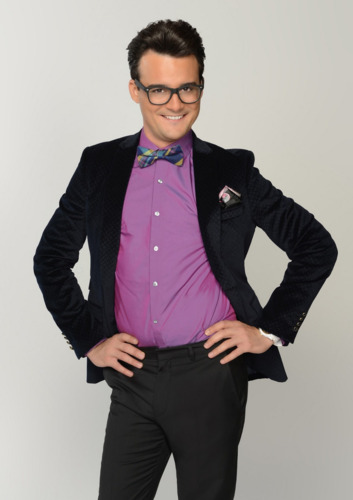
(Rosario "Ro" Flores plays as the gay assistant and faithful consultant of Teresa, he is available to her twenty-four hours of the day in the Telenovela named Marido en Alquiler. He’s very sassy, always wears bright colors, and his behavior is considered dramatic.) (Image Retrieved from Google)
Ro even fits the typical occupation that’s been assigned to so many gay characters within telenovelas—on top of being the gay assistant, he serves as Theresa’s hairdresser. Tate argues, that since the debut of Mexican telenovelas in the mid-twentieth century, the presence of gay male characters for the most part has been limited to the inclusion of effete men who are typically the hair stylists, designers, and/or confidants of the female protagonists or antagonists.” Ro reinforces the ideological idea of hyper feminization of Latin American gay characters in queer television—specifically the “overly glamourized” gay man. In reality, one could easily argue that he projects his image onto his superficially interesting boss.
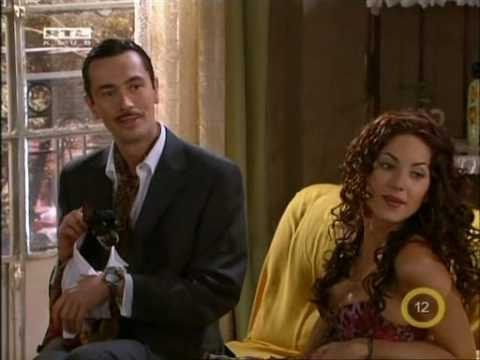
(Scene from an episode where Rubi and Loreto talk about manipulating one of the other characters, Maribel. Loreto can be seen sitting in a more poised position than Rubi. He always carries a lap chihuahua with him, which Rubi comments on, in this scene. Soon after, Loreto sashays across the room, as he makes his dramatic exit.) (Image Retrieved from Google)
Loreto from the telenovela named Rubi also assumes the position of the highly effeminate trusty consultant to the female protagonist, as well as being a high culture fashion designer. He sashays as he walks, he wears a pink handkerchief around his neck, and producers went as far as to incorporate a hand/lap dog who is always in Loreto’s arms. He follows that “gossipy and colorful best friend” theme. Telenovelas often times depict gay men in stereotypical roles which speaks to gender ideologies specifically touching on how the media represents gay Latin character’s attitudes on their place in society. Gay minorities are typically not shown in complex or diverse ways in mainstream media, as touched on by Ciszek. “Many LGBT characters in telenovelas are “relegated to the sidelines,” sending a message to audiences that can lead to marginalizing and trivializing sexual and gender minorities” (Stokes et al., 2016, p. 7), which has evolved into a worrisome trend in Telenovelas.
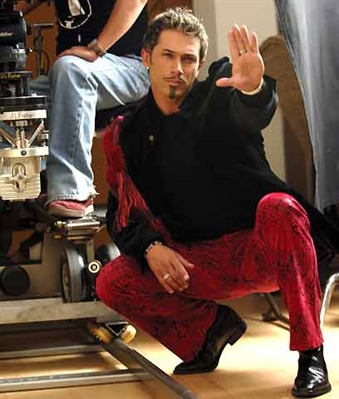
(In his overly flamboyant outfit, Luigi squats down as if he is trying to capture a precious moment. In this scene he is admiring the beauty of one of his fellow cast-mates while dramatically gazing across the room. After this part of the telenovela, another character mocks Luigi, is saying he’s dramatic.) (Image Retrieved from Google)
Gender identity in Mexico has originally been perceived as a strict binary. Which is why female performance is only applicable to women and gay men. Performance of masculine behavior is the privileged region of hetero-men. This binary has a specific roles in the masculinity and the way men perform manliness in Mexico. Telenovelas highlight the LGBT community in a stereotypical light. This relates to gender theory in that the character Luigi from the telenovela named La Fea Mas Bella, plays to the stereotypical gay man in being the “dolled” up, gay best friend, mostly looked at as an accessory. Luigi plays to the over dramatically constructed role where he is considered but another one of the girls.
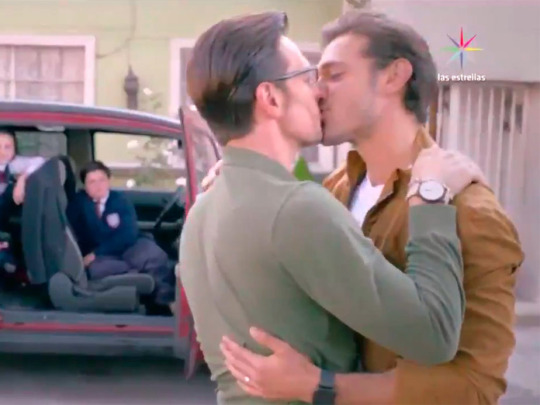
(Two characters share a kiss, while children in the back watch in confusion. A few seconds later the father of the children slams the door close to shield his children from witnessing this “non normal” kiss between his two neighbors.) (Image Retrieved from Google)
In the Brazilian telenovela "Que Pobres Tan Ricos" in 2014, the network Univision prevented for the program to air, due to a gay kiss that was captured in a scene. Three years later, in November 15th of 2017, the same network Univision Mexico ran the first gay kiss through the show "Papá A Toda Madre". This was vital to the breakthrough of these characters because it emulated the relationship of two gay characters in a prime-time television for the first time. Although, corporations and media are being more inclusive, they are still marginalizing and misrepresenting LGBT community to the highest degree. They’re perceived as sissy, girlie, and sassy. This program depicts gay men in a light that further stigmatizes gay men. There is a line in the telenovela, which asks, “¿Quien es la esposa?” (“Who is the wife?”) which goes to show, that there isn’t the same respect for a queer relationship, queer space, overall queerness. Although there is a representation, there is still a stereotypical toxic representation of queer relationship, queer space and queerness overall.
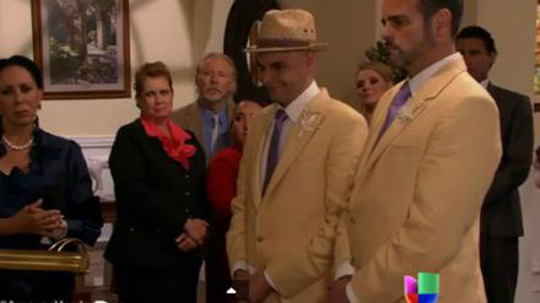
(All gather in celebration of Jean and Estefano’s wedding. All of the people in attendance of this wedding admire the couple, and some even shed tears of joy for the couple. Soon after this, we witness some intimate moments when the couple shares a kiss.) (Image Retrieved from Google)
This is the first gay marriage in a novela and captivates two great examples of the two different types of gay, one can choose to be. The characters In Amores Verdaderos both hold different positions, Jean plays a simple chef, whereas Estefano takes on the image of a masculine guy that aside from his interactions with Jean, shows no feminine gestures. Jean is all over the place and exaggerates all of his emotions and vents/speaks in a way that makes him sound vulnerable. He is but a joke that other characters play off of and can't take seriously making him an accessory to disrespect and use as needed.
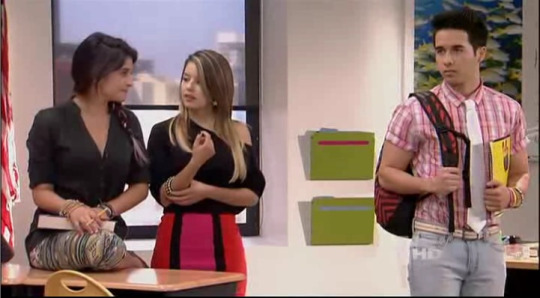
(Saddened because he’s been ridiculed, Alejandro grabs his belonging and stares back with tears in his eyes because of how he’s been bullied for exhibiting girl like characteristics. He’s called a girl because he pays lots of attention to his appearance. He leaves the room and reflects on how he’s rejected after coming out.) (Image Retrieved from Google)
The character Alejandro from Relaciones Peligrosas takes time to find himself and struggles with self acceptance. When he finally has his coming out moment, he becomes that stereotypical image of a gay man. He spends a lot of time being almost an accessory for his best friend and seeks no true relationship. He experiences feelings for a character and is rejected for being flamboyant and out. Other guys acknowledge him as a girl because of how he dresses and cares so much about his appearance. “Presents acceptance by family and friends as the most crucial issues,” this quote captivates how gay characters fall into a role where they are meant to seek the approval of those around them and that might be adjusting who they were to what people expect (Dow, pg.11).
These ideas surrounding “machismo” have been around for so long, and is described as, “Machismo is complex and multifaceted and too often, in Anglo-American interpretations, reduced to self-aggrandizing male bravado that flirts with physical harm to be sexual, like some rutting for the rights to pass on genes”(Coronado). This quote brings on the discussion on how in Latin American culture the acts of being a man are dominated by the hegemonic assumptions on gender. This could range from positions they hold to the role they play with in their environments and what form of position they take around other members of the same sex.
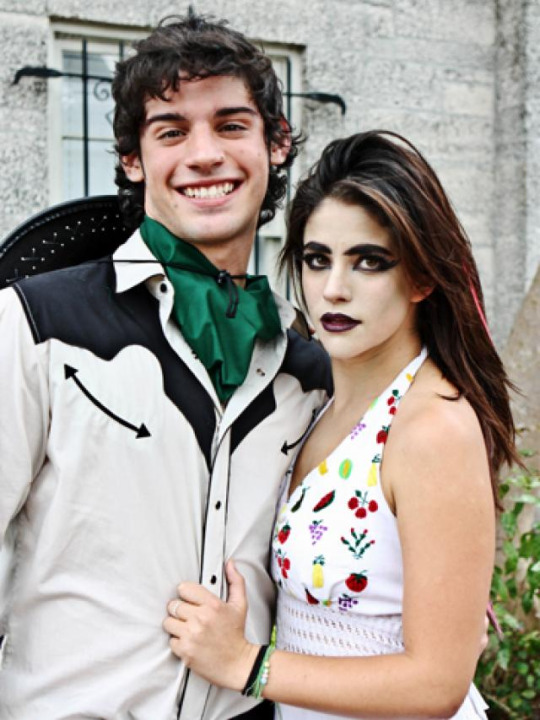
(Diego is seen posing next to Gabriella. Gabriella is the girl who Diego has been having a fake relationship with, in attempts to hide his sexuality.) (Image Retrieved from Google)
When looking at the character Diego in the telenovela named Relaciones Peligrosas, one might notice that he rejects his sexuality and chooses to play the role of a straight man. He is aggressive and can be identified as a bully. He also hopes to follow in his father’s footsteps, in being a doctor. He takes on this persona where he ignores his partner and focuses on work and really any other activity where he is able to look more masculine, such as drinking games and teasing amongst him and his friends. Yet when alone with another gay character he tends to act a little more human.
youtube
(In this scene we see Alejandro a few seconds away from taking pills to cope with how much he’s been bullied about his sexuality. Diego arrives and Alejandro confronts Diego about his indecent actions in concluding that he will not let others especially not Diego, take his power away from him, and kill him by bullying.) (Video Retrieved from Youtube)
After exploring the telenovelas presented, it’s evident that there is a worrisome trend that is very present within Mexican telenovelas. Telenovelas do an amazing job representing love, drama, and comedy, however they continue to misrepresent the queer community—specifically gay Latin men. Though queer representation has increased in Telenovelas, there’s still a prominent pattern of hyper feminization of these gay Latin characters that is harmful because it reinforces false depictions and negative stereotypes. Telenovelas seem to continuously hyper-feminize these characters. Telenovelas also create a sense of machismo in characters which overshadows obstacles, like coming out. Ultimately these two things marginalize and trivialize sexual and gender minorities, sending the wrong message to audiences through Mexico’s largest mainstream media platform, telenovelas.
References
Ciszek, E.L. (2017). Todo Mejora en el Ambiente. Journal of Communication Inquiry 41:4,pages 313-330. Retrieved from http://journals.sagepub.com/doi/10.1177/0196859917712980
Coronado, J. D. (2015). machismo Oxford University Press.doi:10.1093/obo/9780199913701.016.0106
Dow, B. (2001) Ellen, Television, and the Politics of Gay and Lesbian Visibility, Critical Studies in Media Communication, 18:2, 123-140, DOI:10.1080/07393180128077
Rosario "Ro" Flores. (2013, May 23). Retrieved October 15, 2018, from https://www.telemundo.com/series-y-novelas/2013/07/03/rosario-ro-flores
Roth, D. S. (2018, March 21). This is how Spanish-language TV portrays LGBTQ characters, and it's worrisome. Retrieved from https://www.miamiherald.com/news/local/community/gay-south-florida/article206267474.html
Stokes, Z., Trasandes, M., & Quezada, J. (2016). Nearly invisible: LGBTQ representations onSpanish-language television in the United States. GLAAD. Retrieved from http://www.glaad.org/nearly-invisible-casi-invisibles.
Tate, J. (2013). Redefining Mexican masculinity in twenty-first century telenovelas. Hispanic
3 notes
·
View notes